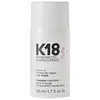What's inside
What's inside
 Key Ingredients
Key Ingredients

 Benefits
Benefits

 Concerns
Concerns

 Ingredients Side-by-side
Ingredients Side-by-side

Water
Skin ConditioningAlcohol Denat.
AntimicrobialPropylene Glycol
HumectantCetearyl Alcohol
EmollientDicaprylyl Ether
EmollientCetyl Esters
EmollientBehentrimonium Chloride
PreservativePolysorbate 20
EmulsifyingSh-Oligopeptide-78
Hydrolyzed Wheat Protein
Skin ConditioningHydrolyzed Wheat Starch
Skin ConditioningIsopropyl Alcohol
SolventTocopherol
AntioxidantPhenoxyethanol
PreservativePotassium Sorbate
PreservativeCitric Acid
BufferingParfum
MaskingGeraniol
PerfumingLinalool
PerfumingHexyl Cinnamal
PerfumingBenzyl Alcohol
PerfumingWater, Alcohol Denat., Propylene Glycol, Cetearyl Alcohol, Dicaprylyl Ether, Cetyl Esters, Behentrimonium Chloride, Polysorbate 20, Sh-Oligopeptide-78, Hydrolyzed Wheat Protein, Hydrolyzed Wheat Starch, Isopropyl Alcohol, Tocopherol, Phenoxyethanol, Potassium Sorbate, Citric Acid, Parfum, Geraniol, Linalool, Hexyl Cinnamal, Benzyl Alcohol
Chenopodium Quinoa Seed Extract
Skin ConditioningCocos Nucifera Oil
MaskingCetearyl Olivate
Sorbitan Olivate
EmulsifyingDecyl Cocoate
EmollientGlyceryl Stearate
EmollientTriethylhexanoin
MaskingAvena Sativa Protein Extract
Skin ConditioningCopper Tripeptide-1
Skin ConditioningAcetyl Hexapeptide-8
HumectantPalmitoyl Pentapeptide-4
Skin ConditioningPalmitoyl Tetrapeptide-7
Skin ConditioningPalmitoyl Tripeptide-1
Skin ConditioningCeramide NP
Skin ConditioningHydrolyzed Corn Protein
Skin ConditioningHydrolyzed Soy Protein
HumectantHydrolyzed Wheat Protein
Skin ConditioningHippophae Rhamnoides Oil
EmollientPentaclethra Macroloba Seed Oil
EmollientPrunus Amygdalus Dulcis Oil
Skin ConditioningAdansonia Digitata Seed Oil
EmollientHelianthus Annuus Seed Oil
EmollientTamarindus Indica Seed Polysaccharide
Skin ConditioningPanthenol
Skin ConditioningGlycerin
HumectantTocopherol
AntioxidantCoco-Caprylate/Caprate
EmollientBehentrimonium Chloride
PreservativePolyglyceryl-10 Laurate
Skin ConditioningDipropylene Glycol
HumectantHydroxyacetophenone
AntioxidantPolyglyceryl-10 Myristate
Skin ConditioningCaprylyl Glycol
EmollientIsopropyl Alcohol
SolventLavandula Hybrida Oil
EmollientLinalool
PerfumingAniba Rosodora Wood Oil
AstringentCananga Odorata Flower Oil
MaskingPelargonium Graveolens Flower Oil
MaskingWater
Skin ConditioningMalt Extract
Skin ProtectingCitronellol
PerfumingGeraniol
PerfumingBenzyl Benzoate
AntimicrobialDipotassium Glycyrrhizate
Humectant1,2-Hexanediol
Skin ConditioningButylene Glycol
HumectantChenopodium Quinoa Seed Extract, Cocos Nucifera Oil, Cetearyl Olivate, Sorbitan Olivate, Decyl Cocoate, Glyceryl Stearate, Triethylhexanoin, Avena Sativa Protein Extract, Copper Tripeptide-1, Acetyl Hexapeptide-8, Palmitoyl Pentapeptide-4, Palmitoyl Tetrapeptide-7, Palmitoyl Tripeptide-1, Ceramide NP, Hydrolyzed Corn Protein, Hydrolyzed Soy Protein, Hydrolyzed Wheat Protein, Hippophae Rhamnoides Oil, Pentaclethra Macroloba Seed Oil, Prunus Amygdalus Dulcis Oil, Adansonia Digitata Seed Oil, Helianthus Annuus Seed Oil, Tamarindus Indica Seed Polysaccharide, Panthenol, Glycerin, Tocopherol, Coco-Caprylate/Caprate, Behentrimonium Chloride, Polyglyceryl-10 Laurate, Dipropylene Glycol, Hydroxyacetophenone, Polyglyceryl-10 Myristate, Caprylyl Glycol, Isopropyl Alcohol, Lavandula Hybrida Oil, Linalool, Aniba Rosodora Wood Oil, Cananga Odorata Flower Oil, Pelargonium Graveolens Flower Oil, Water, Malt Extract, Citronellol, Geraniol, Benzyl Benzoate, Dipotassium Glycyrrhizate, 1,2-Hexanediol, Butylene Glycol
 Reviews
Reviews

Alternatives
Ingredients Explained
These ingredients are found in both products.
Ingredients higher up in an ingredient list are typically present in a larger amount.
This ingredient is a preservative and often used for it's anti-static properties. You'll most likely see this ingredient in hair conditioners.
It does not cause irritation or sensitization in leave-on products at 1-5%.
Geraniol is used to add fragrance/parfum to a product. It is the main component of citronellol. It is a monoterpenoid and an alcohol.
Monoterpenes are naturally found in many parts of different plants.
Geraniol can be found in many essential oils including Rose Oil and Citronella Oil. The scent of Geraniol is often described as "rose-like". Many foods also contain Geraniol for fruit flavoring.
Geraniol can irritate the skin when exposed to air. However, irritation depends on the ability of geraniol to penetrate into the skin. In general, geraniol is not able to penetrate skin easily.
Geraniol is colorless and has low water-solubility. However, it is soluble in common organic solvents.
Like citronellol, it is a natural insect repellent.
2,6-Octadien-1-ol, 3,7-dimethyl-, (2E)-
Learn more about GeraniolWe don't have a description for Hydrolyzed Wheat Protein yet.
Isopropyl Alcohol is more commonly known as rubbing alcohol. It is most commonly used as a solvent, meaning it helps other ingredients dissolve.
This ingredient is an astringent alcohol. Astringent alcohols may also irritate skin as they high amounts may strip away your skin's natural oils.
Other types of astringent alcohols include:
According to the National Rosacea Society based in the US, you should be mindful of products with these alcohols in the top half of ingredients.
Any type of sanitizing product will have high amounts of alcohol to help kill bacteria and viruses.
Learn more about Isopropyl AlcoholLinalool is a fragrance and helps add scent to products. It's derived from common plants such as cinnamon, mint, citrus, and lavender.
Like Limonene, this ingredient oxidizes when exposed to air. Oxidized linalool can cause allergies and skin sensitivity.
This ingredient has a scent that is floral, spicy tropical, and citrus-like.
Learn more about LinaloolTocopherol (also known as Vitamin E) is a common antioxidant used to help protect the skin from free-radicals and strengthen the skin barrier. It's also fat soluble - this means our skin is great at absorbing it.
Vitamin E also helps keep your natural skin lipids healthy. Your lipid skin barrier naturally consists of lipids, ceramides, and fatty acids. Vitamin E offers extra protection for your skin’s lipid barrier, keeping your skin healthy and nourished.
Another benefit is a bit of UV protection. Vitamin E helps reduce the damage caused by UVB rays. (It should not replace your sunscreen). Combining it with Vitamin C can decrease sunburned cells and hyperpigmentation after UV exposure.
You might have noticed Vitamin E + C often paired together. This is because it is great at stabilizing Vitamin C. Using the two together helps increase the effectiveness of both ingredients.
There are often claims that Vitamin E can reduce/prevent scarring, but these claims haven't been confirmed by scientific research.
Learn more about TocopherolWater. It's the most common cosmetic ingredient of all. You'll usually see it at the top of ingredient lists, meaning that it makes up the largest part of the product.
So why is it so popular? Water most often acts as a solvent - this means that it helps dissolve other ingredients into the formulation.
You'll also recognize water as that liquid we all need to stay alive. If you see this, drink a glass of water. Stay hydrated!
Learn more about Water